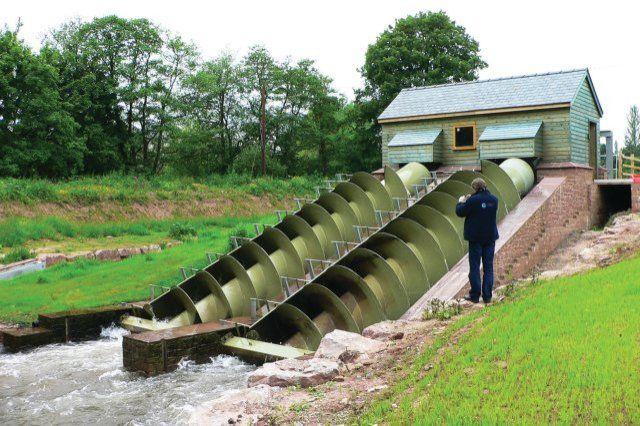Small Hydropower Market is driven by increasing renewable energy demand
Small hydropower systems, typically defined as installations generating up to 10 MW, harness the kinetic energy of rivers and streams to produce clean, reliable electricity with minimal environmental impact. These run‐of‐river and low‐head technologies feature modular designs and scalable capacities, allowing developers to customize projects for remote villages, industrial off‐grid sites, and urban microgrid integrations. The inherent advantages of small hydropower include low operational costs, long asset lifespans, and high capacity factors compared with other renewables, making them an attractive addition to diversified energy portfolios.
Technological advancements in turbine materials and digital control systems enable predictive maintenance and optimized performance, while streamlined permitting processes reduce time-to-market. With growing emphasis on carbon reduction and energy security, small hydropower meets the need for decentralized generation, water resource management, and rural electrification. Market trends indicate rising investments in community-scale micro-hydro plants, and emerging Small Hydropower Market opportunities are expanding across regions with abundant water flows but limited grid infrastructure.
The small hydropower market is estimated to be valued at USD 2.33 billion in 2025 and is expected to reach USD 3.007 billion by 2032, growing at a compound annual growth rate (CAGR) of 3.00% from 2025 to 2032.
Key Takeaways
Key players operating in the Small Hydropower Market are:
-Andritz AG
-Bharat Heavy Electricals Limited
-FLOVEL Energy Private Limited
-GE Renewable Energy
-Gilbert Gilkes & Gordon Ltd
These market players collectively account for a significant share of global small hydropower installations by offering comprehensive portfolios of turbines, generators, and digital monitoring systems tailored for capacities under 10 MW. Andritz AG focuses on high-efficiency turbine designs, while Bharat Heavy Electricals Limited leverages its domestic manufacturing prowess and turnkey execution capabilities in India. FLOVEL Energy excels in community-scale micro-hydro solutions for rural electrification, complementing off-grid energy access initiatives. GE Renewable Energy brings advanced digitalization and remote monitoring features to maximize uptime, and Gilbert Gilkes & Gordon Ltd offers engineered components and maintenance services that adhere to stringent environmental standards. Through sustained R&D investment and strategic alliances, these companies shape market dynamics and set benchmarks for reliability, cost-effectiveness, and compliance with evolving regulatory requirements.
Increasing global emphasis on renewable energy has stimulated robust market growth for small hydropower solutions. Demand is rising in developing economies and remote regions lacking stable grid infrastructure, where decentralized generation enhances energy security and resilience. Market research reveals that rural electrification programs and community microgrid deployments serve as key growth drivers, tapping into market opportunities for low-impact hydro installations. Energy demand in Asia-Pacific nations, coupled with favorable government incentives, underscores the importance of small hydropower in meeting regional carbon-reduction targets. Technological improvements—such as modular turbine components and streamlined civil works—are lowering capital expenditures and accelerating project timelines. Companies deploy tailored market growth strategies based on localized water resource assessments and stakeholder engagement, ensuring alignment with local development goals and reinforcing small hydropower’s role in comprehensive energy transition roadmaps.
‣ Small Hydropower Market: https://www.coherentmi.com/industry-reports/small-hydropower-market
Small hydropower systems, typically defined as installations generating up to 10 MW, harness the kinetic energy of rivers and streams to produce clean, reliable electricity with minimal environmental impact. These run‐of‐river and low‐head technologies feature modular designs and scalable capacities, allowing developers to customize projects for remote villages, industrial off‐grid sites, and urban microgrid integrations. The inherent advantages of small hydropower include low operational costs, long asset lifespans, and high capacity factors compared with other renewables, making them an attractive addition to diversified energy portfolios.
Technological advancements in turbine materials and digital control systems enable predictive maintenance and optimized performance, while streamlined permitting processes reduce time-to-market. With growing emphasis on carbon reduction and energy security, small hydropower meets the need for decentralized generation, water resource management, and rural electrification. Market trends indicate rising investments in community-scale micro-hydro plants, and emerging Small Hydropower Market opportunities are expanding across regions with abundant water flows but limited grid infrastructure.
The small hydropower market is estimated to be valued at USD 2.33 billion in 2025 and is expected to reach USD 3.007 billion by 2032, growing at a compound annual growth rate (CAGR) of 3.00% from 2025 to 2032.
Key Takeaways
Key players operating in the Small Hydropower Market are:
-Andritz AG
-Bharat Heavy Electricals Limited
-FLOVEL Energy Private Limited
-GE Renewable Energy
-Gilbert Gilkes & Gordon Ltd
These market players collectively account for a significant share of global small hydropower installations by offering comprehensive portfolios of turbines, generators, and digital monitoring systems tailored for capacities under 10 MW. Andritz AG focuses on high-efficiency turbine designs, while Bharat Heavy Electricals Limited leverages its domestic manufacturing prowess and turnkey execution capabilities in India. FLOVEL Energy excels in community-scale micro-hydro solutions for rural electrification, complementing off-grid energy access initiatives. GE Renewable Energy brings advanced digitalization and remote monitoring features to maximize uptime, and Gilbert Gilkes & Gordon Ltd offers engineered components and maintenance services that adhere to stringent environmental standards. Through sustained R&D investment and strategic alliances, these companies shape market dynamics and set benchmarks for reliability, cost-effectiveness, and compliance with evolving regulatory requirements.
Increasing global emphasis on renewable energy has stimulated robust market growth for small hydropower solutions. Demand is rising in developing economies and remote regions lacking stable grid infrastructure, where decentralized generation enhances energy security and resilience. Market research reveals that rural electrification programs and community microgrid deployments serve as key growth drivers, tapping into market opportunities for low-impact hydro installations. Energy demand in Asia-Pacific nations, coupled with favorable government incentives, underscores the importance of small hydropower in meeting regional carbon-reduction targets. Technological improvements—such as modular turbine components and streamlined civil works—are lowering capital expenditures and accelerating project timelines. Companies deploy tailored market growth strategies based on localized water resource assessments and stakeholder engagement, ensuring alignment with local development goals and reinforcing small hydropower’s role in comprehensive energy transition roadmaps.
‣ Small Hydropower Market: https://www.coherentmi.com/industry-reports/small-hydropower-market
Small Hydropower Market is driven by increasing renewable energy demand
Small hydropower systems, typically defined as installations generating up to 10 MW, harness the kinetic energy of rivers and streams to produce clean, reliable electricity with minimal environmental impact. These run‐of‐river and low‐head technologies feature modular designs and scalable capacities, allowing developers to customize projects for remote villages, industrial off‐grid sites, and urban microgrid integrations. The inherent advantages of small hydropower include low operational costs, long asset lifespans, and high capacity factors compared with other renewables, making them an attractive addition to diversified energy portfolios.
Technological advancements in turbine materials and digital control systems enable predictive maintenance and optimized performance, while streamlined permitting processes reduce time-to-market. With growing emphasis on carbon reduction and energy security, small hydropower meets the need for decentralized generation, water resource management, and rural electrification. Market trends indicate rising investments in community-scale micro-hydro plants, and emerging Small Hydropower Market opportunities are expanding across regions with abundant water flows but limited grid infrastructure.
The small hydropower market is estimated to be valued at USD 2.33 billion in 2025 and is expected to reach USD 3.007 billion by 2032, growing at a compound annual growth rate (CAGR) of 3.00% from 2025 to 2032.
Key Takeaways
Key players operating in the Small Hydropower Market are:
-Andritz AG
-Bharat Heavy Electricals Limited
-FLOVEL Energy Private Limited
-GE Renewable Energy
-Gilbert Gilkes & Gordon Ltd
These market players collectively account for a significant share of global small hydropower installations by offering comprehensive portfolios of turbines, generators, and digital monitoring systems tailored for capacities under 10 MW. Andritz AG focuses on high-efficiency turbine designs, while Bharat Heavy Electricals Limited leverages its domestic manufacturing prowess and turnkey execution capabilities in India. FLOVEL Energy excels in community-scale micro-hydro solutions for rural electrification, complementing off-grid energy access initiatives. GE Renewable Energy brings advanced digitalization and remote monitoring features to maximize uptime, and Gilbert Gilkes & Gordon Ltd offers engineered components and maintenance services that adhere to stringent environmental standards. Through sustained R&D investment and strategic alliances, these companies shape market dynamics and set benchmarks for reliability, cost-effectiveness, and compliance with evolving regulatory requirements.
Increasing global emphasis on renewable energy has stimulated robust market growth for small hydropower solutions. Demand is rising in developing economies and remote regions lacking stable grid infrastructure, where decentralized generation enhances energy security and resilience. Market research reveals that rural electrification programs and community microgrid deployments serve as key growth drivers, tapping into market opportunities for low-impact hydro installations. Energy demand in Asia-Pacific nations, coupled with favorable government incentives, underscores the importance of small hydropower in meeting regional carbon-reduction targets. Technological improvements—such as modular turbine components and streamlined civil works—are lowering capital expenditures and accelerating project timelines. Companies deploy tailored market growth strategies based on localized water resource assessments and stakeholder engagement, ensuring alignment with local development goals and reinforcing small hydropower’s role in comprehensive energy transition roadmaps.
‣ Small Hydropower Market: https://www.coherentmi.com/industry-reports/small-hydropower-market
0 Comments
0 Shares

